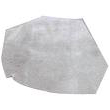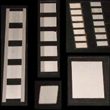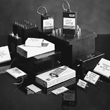CONDENSER MICA PLATES FOR CAPACITORS

Cut mica plates are specially made of superior quality muscovite ruby clear mica films, split and gauged to a specified range of thickness varying between 20 to 100 microns into a close controllable tolerance within a micron, suitable for use in the manufacture of silvered mica plates and mica capacitors. Plain smooth surface, clean punched sharp edges, uniform thickness, free from metallic stains, spots, finger prints, scratches, cracks, tears, pin-holes, stones, buckles, ridges, etc., are some of the important points observed while manufacturing cut mica plates. They are manufactured as per ASTM Specifications: D748-71,possessing electrical, physical and visual quality requirements as specified in the following table.
SILVERED MICA PLATES

All cut mica plates are electrically tested by means of a high frequency spark for conducting particles and pinholes. They are then metallised with a silver paste by a screen printing method to form a thin electrodes-less than 3 mm. Silver paste is printed onto the mica in different patterns as per required specification. The actual silver metallisation is done within a range of 5 to 8 microns on both sides.The deposited layer of silver is controlled to achieve its required capacitance. Glass is used as the fusing agent. The metallising bond which unites these two elements permits diffusion of heat over a wider surface. While the points of calorofic transfer are increased, the thermic resistance does not influence the insulation of the unmetallised area of the film.
MICA CAPACITORS

Mica capacitors are manufactured out of silvered mica plates staked alternatively between layers of metallic foils (brass, tin, alloy, lead or copper) and then clamped together to produce voids between the foils and the dielectric, as well as, to reduce the capacitance variation and size to improve stability. On each of the stake an annealed copper lead wire contact or terminal is soldered. The assembly is dipcoated with phenol formaldehyde or other selected natural or synthetic resins and then vacuum impregnated with a high melting petroleum wax to eliminate the deterioration effect of the moisture and finally encapsulated. The type of encasing materials employed are important s their dielectric leakage and temperature limitations often restrict the performance of mica capacitors.